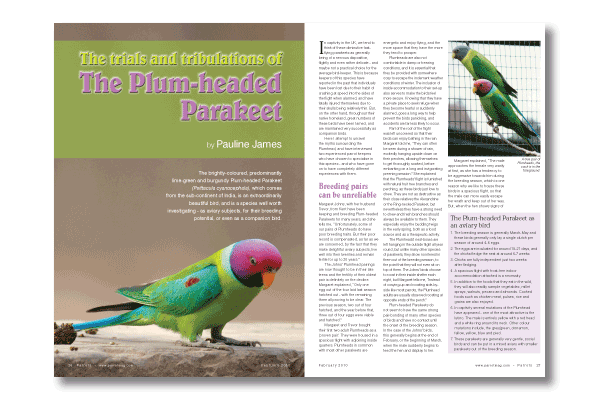Pauline James
In captivity in the UK, we tend to think of these diminutive fast-flying parakeets as generally being of a nervous disposition, flightly and even rather delicate - and maybe not a practical choice for the average bird-keeper. This is because keepers of this species have reported in the past that individuals have been lost due to their habit of crashing at speed into the sides of the flight when alarmed, and have fatally injured themselves due to their skulls being relatively thin. But, on the other hand, throughout their native homeland, great numbers of these birds have been tamed, and are maintained very successfully as companion birds.
Here I attempt to unravel the myths surrounding the Plumhead, and have interviewed two experienced parrot keepers who have chosen to specialise in this species - and who have gone on to have completely different experiences with them.
Breeding pairs can be unreliable
Margaret Johns, with her husband Trevor, from Kent have been keeping and breeding Plum-headed Parakeets for many years, and she tells me, “Unfortunately, some of our pairs of Plumheads do have poor breeding traits. But their poor record is compensated, as far as we are concerned, by the fact that they make delightful aviary subjects, live well into their twenties and remain fertile for up to 20 years.”
The Johns’ Plumhead pairings are now thought to be in their late teens and the fertility of their oldest pair is definitely on the decline. Margaret explained, “Only one egg out of the four laid last season hatched out - with the remaining three all proving to be clear. The previous season, two out of four hatched, and the year before that, three out of four eggs were viable and hatched.”
Margaret and Trevor bought their first two adult Plumheads as a ‘proven pair.’ They were housed in a spacious flight with adjoining inside quarters. Plumheads in common with most other parakeets are energetic and enjoy flying, and the more space that they have the more they tend to prosper.
Read more in the magazine…









Parrot Chat
Buyers Guides
Breeding articles